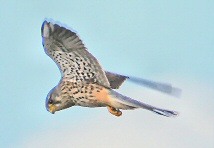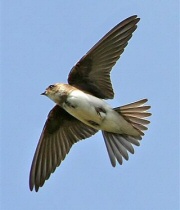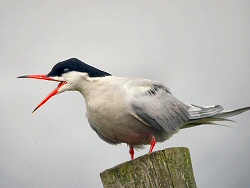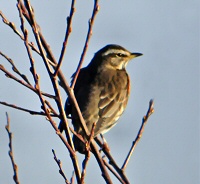Winter (January & February)
The lagoons are a great place to start off the New Year, a refreshing walk to re-invigorate you after the holiday festivities will often be rewarded by some excellent birds. Entering the site from Teal Close you may see a flash of vivid blue as the Kingfisher zooms along the Ouse Dyke a little patience may gain you a view of this stunning bird perched along the bank. A Grey Wagtail is also often seen along the dyke, characteristically bobbing its tail and dashing along the muddy edges catching insects.
Commoner species such as Wren, Dunnock, Blackbird, Chaffinch, Blue Tit, Great Tit will be seen along the hedge often joined by a feeding party of Long-tailed Tits moving through giving their delightful contact calls whilst a Song Thrush is busy smashing snails on its ‘anvil’ under the bushes on the opposite bank.
Crossing over the footbridge on to the actual reserve take a moment to scan the fields, Pied Wagtails, Common Pheasant, Rook, Carrion Crow, Jackdaw will often be in evidence and you may also find Linnet, Yellowhammer, Lapwing, Grey Partridge and Mistle Thrush. Depending on the vegetation in the fields you may also encounter a small flock of Golden Plover hiding amongst the furrows, along with our Scandinavian winter visitors, Fieldfare & Redwing.
Around the footbridge is often a good place to see Bullfinches giving away their presence with their soft ‘phu’ calls. After climbing the steps of the slurry pit bank you should see and hear Redwings as they feed along the hedge bottoms and any Fieldfares flying over will announce themselves with their distinctive ‘schack-schack-schack’ calls. The slurry pit itself should hold good numbers of Teal, Shoveler, Gadwall, Pochard, Tufted Duck, Mallard, Coot and Moorhen with a few Little Grebe and maybe one or two Shelduck and Goldeneye. The apparently empty reed beds will actually hold several Reed Buntings which will flit down to the path edges as they feed. Along the water line, depending on the water level, you may see several Snipe as they roost or feed on the reed fringes.
A familiar sound at this time of year is the slightly alarming squeal of Water Rail which may be heard from any of the reed beds the best chances of seeing this secretive bird are when it flutters low across the water between reed beds or when it ventures out along more exposed shores to feed, especially in freezing conditions. These muddy edges may also attract waders such as Dunlin, Redshank, Common Sandpiper or Green Sandpiper.
The number of gulls on the slurry lagoon varies greatly depending on the time of day and the prevailing weather conditions. After early morning groups have dispersed many drift in and out during the day as they move into the adjacent farmland or further away to feed. Mid-afternoon often sees a gathering of gulls loafing around the lagoon. The most common species is Black-headed Gull with much smaller numbers of Common Gull. The large gulls are mainly Lesser Black-backed and Herring Gulls with smaller numbers of Great Black-backed Gulls, it is always worth searching the gull flocks as Iceland, Glaucous, Yellow-legged and Mediterranean Gull have all be recorded here in the winter months.
The Deep Pit will hold similar wildfowl species to those already encountered and Great Crested Grebes with probably have one or two Cormorants fishing whilst others rest and dry their wings on top of the nearby electricity pylon. The banks of the Deep Pit may hold a few wintering Meadow Pipit and an occasional Stonechat. Walking towards the railway bank you will invariably hear the ‘yaffle’ call of a Green Woodpecker and maybe see its lime-green back as it bounds away from you. If very lucky the explosive song of the Cetti’s Warbler may be heard but sightings are much more difficult to obtain.
The path along the railway bank is usually productive and sought after species such as Redpoll, Siskin and Willow Tit can often be seen with a little patience, the latter often visiting the bird table at the bottom of the bank near the signal box.
Both Pied and Grey Wagtails are often seen around the railway bridge and Stock Doves can be seen in the fields and on the wires across the river. The fields & river also have Canada & Greylag Geese, Wigeon and a few Grey Herons with the possibility of Redshank, Oystercatcher, Goldeneye or even a Goosander.

The Gravel Pits hold varying numbers of wildfowl but this is where you should see the highest numbers of Wigeon and careful searching of the Tufted Ducks may be rewarded with views of the occasional Scaup and Smew. Kestrels hunt over the grassy areas and Sparrowhawks may be encountered anywhere but especially along the hedges. A walk along the dense hedge between the fields and the gravel pits may reveal an over wintering Chiffchaff or even a Blackcap.
Spring (March/April/May)

Spring is always a season of change as the leaves begin to unfurl, the first migrants and summer visitors are eagerly anticipated as the winter visitors start to drift away. Friendly competition drives the local patch regulars to spend more hours of the lengthening days in the field hoping to get the first record of the year for each species. Sand Martins are often the first to return with some passing thorough as early as the second week of March closely followed by the first early Swallows, these are often few in number and pass straight through on their journey north, the main arrival occurs in late March and early April.
Little Ringed Plovers start appearing from the third week in March and can be seen performing their aerial courtship displays throughout early spring. The warblers then start to arrive and mornings can become very noisy with Blackcap, Chiffchaff, Willow Warbler, Common Whitethroat, Sedge Warbler and Reed Warbler all singing heartily to attract a mate and declare their territory. A special treat at this time is to hear several Grasshopper Warblers delivering their reeling song from the scrub and bramble patches, before the leaves fully develop is the best time to catch a glimpse of these beautiful songsters.
The growing chorus is then joined by newly arrived Garden Warblers and Lesser Whitethroats, the latter often favouring the taller trees and bushes along the railway bank. The familiar call of the Cuckoo is heard, especially around the Deep Pit and the Gravel Pit, if you hear one search along the fence posts for the chance of a good sighting.

Yellow Wagtails will be found on the fields or the grass banks across the river and House Martins will be seen around the bridge as Swallows begin to nest under the bridge itself. Sand Martins begin nesting in the river bank and Common Terns will have returned to the nesting platforms on the Deep Pit.
By early May good numbers of Swifts can be seen feeding over and around the reserve and the Hobby will be putting in regular appearances as it hunts over the lagoons.
Spring is a great time to see more scarce birds pass through some are annual such as Northern Wheatear, Whinchat, Arctic Tern, Ringed Plover and Whimbrel. You may be fortunate to see some less frequent visitors such as Garganey, Marsh Harrier, Osprey, Black Tern, Little Gull and Common Redstart, anything is possible, as proven in May 2001 when a Little Swift spent 4 days feeding over the fields and lagoons and roosting overnight on the railway bridge.
Summer (June/July/August)
After the hyper activity of spring things start to calm down as we move into the summer and breeding gets fully underway with the first fledglings appearing. The reserve is taken over by the beautiful summer flowers and their attendant butterflies, damselflies and dragonflies as the days become long and lazy.
Wader species that breed in the tundra regions start to occur on return passage as early as July which may be failed breeders or juvenile birds, these may include Dunlin, Green Sandpiper, Greenshank, Wood Sandpiper, Knot, and Curlew Sandpiper. The chances of seeing any of these stop over at the lagoons largely depends on the water levels and a fair degree of good luck.
Autumn (September/October/November)
The summer visitors disappear as migration gets underway with more waders such as Black-tailed Godwit, Bar-tailed Godwit and Ruff passing through along with warblers as they head south after breeding.

October sees the return of the first Redwings and Fieldfares which may also bring in one or two Brambling. Northern Wheatear, Whinchat, and Stonechat may be seen lingering for a few days and Siskins & Redpolls will arrive. The wildfowl numbers begin to build again and may include something a little more unusual such as a Pintail or Egyptian Goose, while careful sky watching could see the first flocks of Pink-footed Geese flying over or even a few Whooper Swans.
Winter Returns (December)
The rapidly shortening days and cold nights return as winter takes hold but there are still things to see at the lagoons as wildfowl numbers continue to grow, large concentrations of gulls form on the slurry lagoon and the fortunate visitor may catch sight of a Little Egret or even a Bittern before it disappears into the reed bed.